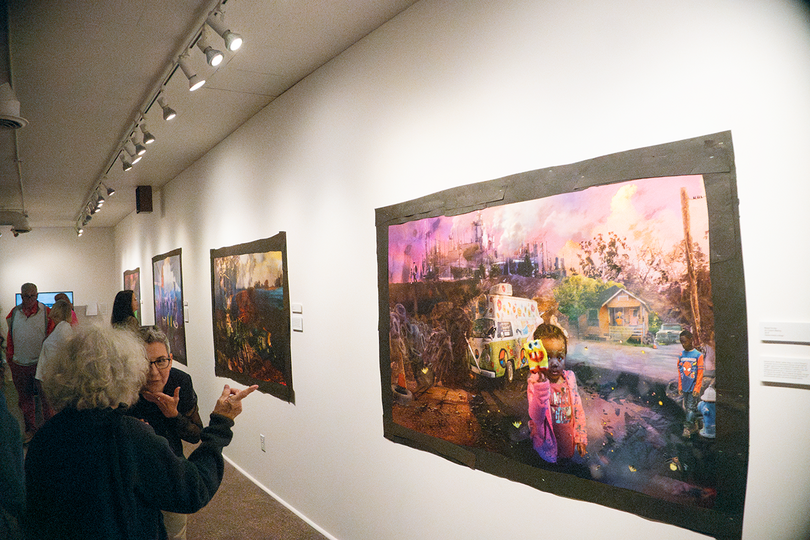‘Poor People’s Campaign’ deploys Afrofuturism against pollution, racism

Visitors admired Najee Dorsey's "Ice Cream Melting" at the opening of his digital collage gallery on Saturday. The piece combines industrial images and cultural references in environmental advocacy. Nathaniel Harnedy | Contributing Photographer
Get the latest Syracuse news delivered right to your inbox.
Subscribe to our newsletter here.
Artist Najee Dorsey finds inspiration in the very communities he wants to represent. His digital collages use his own photographs combined with imaginary aspects to create commentary on environmental racism.
“It’s going to allow for some conversations to be had,” artist Najee Dorsey said. “Perhaps it might inspire some who weren’t engaged to get engaged.”
The exhibit “Poor People’s Campaign” is a digital collage series by Dorsey that confronts environmental racism, industrial pollution and the perseverance of people living in disadvantaged communities. It’s on display at ArtRage Gallery until Oct. 25.
Blending Afrofuturism with social criticism, the collection uses collages to highlight how environmental destruction disproportionately impacts marginalized communities. It’s the second time the full collection has been displayed, and the first time it’s being shown at full size. Because he works with a digital medium, Dorsey said the size of the works changed the effect of the collection, making the work more dynamic and impactful.
The collages layer industrial imagery of factories, cities or railways with cultural and historical references, like a McDonald’s cup and a Southern sugar cane refinery. The scenes are both futuristic and rooted in lived experience, Dorsey said. Black roofing paper frames each image; the non-uniform edges and staples are part of the artwork. There’s beauty in this imperfection, Dorsey said.
One of the pieces, “Bad Habits,” took inspiration from an environmental documentary Dorsey watched while doing research for the collection. It features a lake full of factory runoff, and a small Black child about to jump into it. The piece juxtaposes the joy of summer with the dangerous environmental circumstances that some communities face, Dorsey said.
Some aspects of his artwork are based on real people and places, Dorsey said. But often, he takes his observations of the world and combines them into imaginary scenarios.
“Each piece tells a different story,” Dorsey said. “It’s part of a collection and a body of work, but it’s intentional. I’m focused on one given thing in one story that I’m telling in each single piece.”

Attendees at ArtRage Gallery learned about the dangers of industrial pollution and environmental racism in tandem with Najee Dorsey’s “Poor People’s Campaign” digital collage series. Nathaniel Harnedy | Contributing Photographer
Dorsey’s collage, “Southern Futurist Over Civil War Soil,” depicts a piece of the artist’s imagined dystopian future. He merges an American Civil War battleground with futuristic elements, like children riding floating circles for transportation. Smog rises in the background from a distant nuclear plant, and there is a red haze in the air.
Some of the piece’s themes are more subtle, Dorsey said. He purposefully included the red, green and black colors in one of the children’s clothing, representing the colors of the African liberation movements.
“You probably wouldn’t notice the colors unless you are Black, and maybe not even then, but it’s a little nod to the fact that if we want to be saved, we just might have to save ourselves,” Dorsey said.
Kimberly McCoy, the gallery’s co-director, said Najee and his “Poor People’s Campaign” were a natural choice for the exhibition, given the gallery’s mission to highlight work on social justice and environmental issues.
“Syracuse has one of the highest lead-poisoning rates in the country, it also has very high asthma rates,” McCoy said. “These images aren’t depicting Syracuse, but it was about recognizing that this is an issue our community has.”
Some exhibit attendees, like Mary Slechta, said they see themselves in the artwork. Slechta is a Syracuse resident and long-time fan of Dorsey’s work. She said her grandchildren got excited when they saw kids in the art who looked like them.
“I brought (my grandson) because it’s a good place where we can start talking about things,” Slechta said. “He is getting exposed to environmental justice and things like that in a way he can understand.”
In some pieces, Dorsey enjoyed including irony. The collage titled “People in Power Say Oh, Poor Dog” depicted immigrant children struggling next to a bedraggled white dog. The work elicits sympathy from the viewer — but for which character?
“There’s a segment of society that just doesn’t give a damn, you know? There are people that would look at that painting, at the immigrants suffering, and go, ‘Oh poor dog,’” Dorsey said.
Through all of his pieces, Dorsey aimed to inspire viewers to become more active in their community and educate themselves about the issues they’re surrounded by.
“Art can spark dialogue,” Dorsey said. “It can spark debate. It can spark change.”






